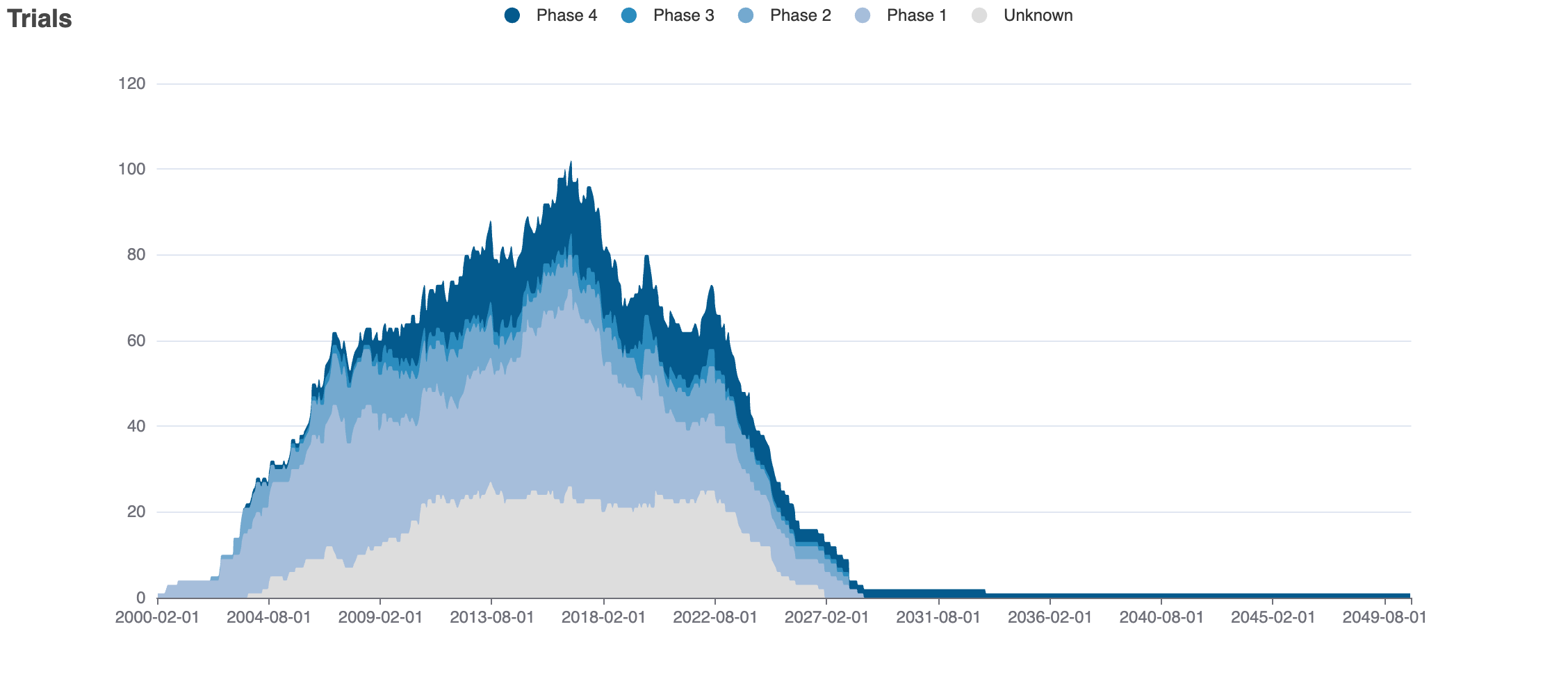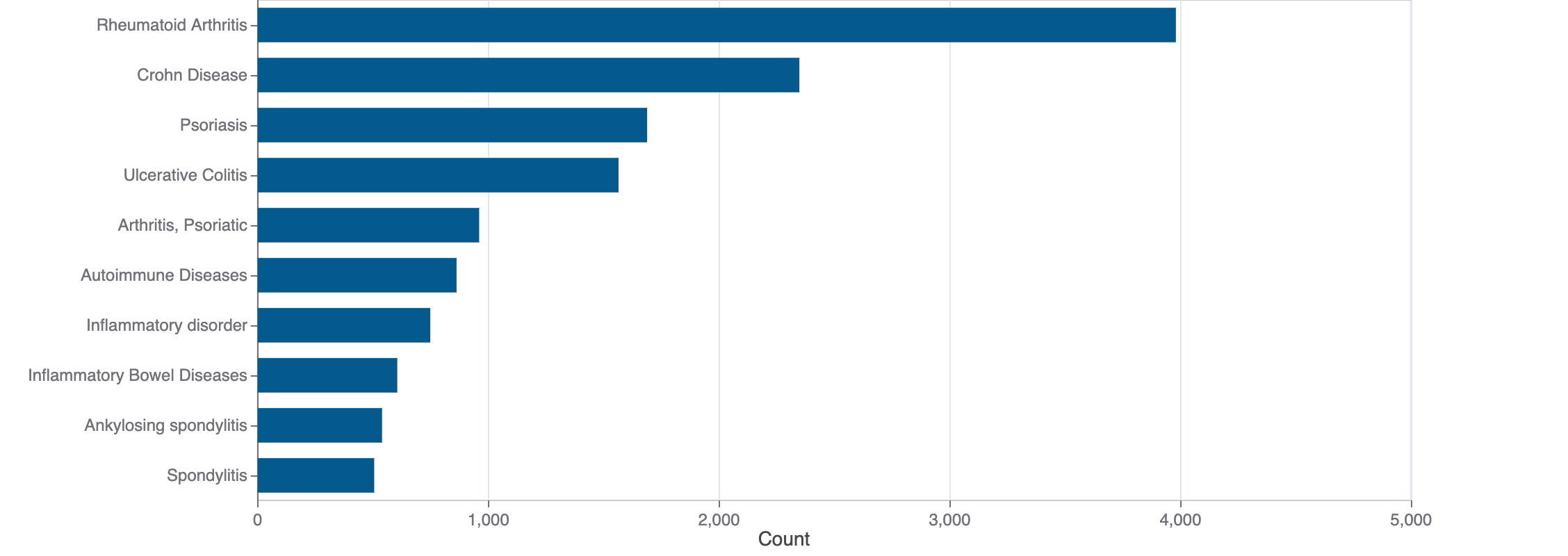Caprelsa(vandetanib)
Caprelsa (vandetanib) is a small molecule pharmaceutical. Vandetanib was first approved as Caprelsa on 2011-04-06. It is used to treat thyroid neoplasms in the USA. It has been approved in Europe to treat thyroid neoplasms. The pharmaceutical is active against vascular endothelial growth factor receptor 2 and proto-oncogene tyrosine-protein kinase receptor Ret. In addition, it is known to target epidermal growth factor receptor.
Download report
Favorite
Events Timeline
Commercial
Clinical
Drug
Target
Variants
Financial
Trends
Safety
Events Timeline
5D
1M
3M
6M
YTD
1Y
2Y
5Y
Max
Events
FDA approval date
EMA approval date
Patent expiration date
Study first post date
Last update post date
Start date
Primary completion date
Completion date
Results first post date

Mock data
Subscribe for the real data
Subscribe for the real data
Commercial
Therapeutic Areas
Therapeutic Area | MeSH |
|---|---|
| neoplasms | D009369 |
| endocrine system diseases | D004700 |
Trade Name
FDA
EMA
Caprelsa
Labels
FDA
EMA
Brand Name | Status | Last Update |
|---|---|---|
| caprelsa | New Drug Application | 2025-11-03 |
Indications
FDA
EMA
Indication | Ontology | MeSH | ICD-10 |
|---|---|---|---|
| thyroid neoplasms | EFO_0003841 | D013964 | — |
Agency Specific
FDA
EMA
No data
Patent Expiration
Patent | Expires | Flag | FDA Information |
|---|---|---|---|
| Vandetanib, Caprelsa, Genzyme Corp | |||
| 8067427 | 2028-08-08 | DP | |
HCPCS
No data
Clinical
Clinical Trials
114 clinical trials
View more details

Mock data
Subscribe for the real data
Subscribe for the real data
Indications Phases 4
Indication | MeSH | Ontology | ICD-10 | Ph 1 | Ph 2 | Ph 3 | Ph 4 | Other | Total |
|---|---|---|---|---|---|---|---|---|---|
| Thyroid neoplasms | D013964 | EFO_0003841 | — | 4 | 8 | 5 | 1 | 3 | 18 |
| Neoplasm metastasis | D009362 | EFO_0009708 | — | 3 | 4 | — | 1 | — | 8 |
| Medullary carcinoma | D018276 | — | — | 1 | 1 | 1 | 1 | — | 4 |
Indications Phases 3
Indication | MeSH | Ontology | ICD-10 | Ph 1 | Ph 2 | Ph 3 | Ph 4 | Other | Total |
|---|---|---|---|---|---|---|---|---|---|
| Non-small-cell lung carcinoma | D002289 | — | — | 8 | 11 | 4 | — | — | 23 |
| Lung neoplasms | D008175 | — | C34.90 | 7 | 11 | 4 | — | — | 22 |
| Thyroid diseases | D013959 | — | E00-E07 | 3 | 8 | 4 | — | 2 | 14 |
| Papillary thyroid cancer | D000077273 | — | — | 5 | 4 | 3 | — | 2 | 11 |
| Carcinoma | D002277 | — | C80.0 | 3 | 6 | 1 | — | — | 8 |
| Neuroendocrine carcinoma | D018278 | — | — | 2 | 3 | 3 | — | 2 | 8 |
Indications Phases 2
Indication | MeSH | Ontology | ICD-10 | Ph 1 | Ph 2 | Ph 3 | Ph 4 | Other | Total |
|---|---|---|---|---|---|---|---|---|---|
| Neoplasms | D009369 | — | C80 | 9 | 8 | — | — | 1 | 17 |
| Breast neoplasms | D001943 | EFO_0003869 | C50 | 2 | 7 | — | — | — | 9 |
| Colorectal neoplasms | D015179 | — | — | 5 | 2 | — | — | — | 7 |
| Prostatic neoplasms | D011471 | — | C61 | 1 | 4 | — | — | — | 5 |
| Glioblastoma | D005909 | EFO_0000515 | — | 4 | 2 | — | — | — | 5 |
| Gliosarcoma | D018316 | — | — | 3 | 2 | — | — | — | 4 |
| Urinary bladder neoplasms | D001749 | — | C67 | — | 3 | — | — | — | 3 |
| Transitional cell carcinoma | D002295 | — | — | — | 3 | — | — | — | 3 |
| Pancreatic neoplasms | D010190 | EFO_0003860 | C25 | 2 | 1 | — | — | — | 3 |
| Head and neck neoplasms | D006258 | — | — | 2 | 1 | — | — | — | 3 |
Show 36 more
Indications Phases 1
Indication | MeSH | Ontology | ICD-10 | Ph 1 | Ph 2 | Ph 3 | Ph 4 | Other | Total |
|---|---|---|---|---|---|---|---|---|---|
| Glioma | D005910 | EFO_0000520 | — | 5 | — | — | — | 1 | 6 |
| Adenocarcinoma | D000230 | — | — | 4 | — | — | — | — | 4 |
| Healthy volunteers/patients | — | — | — | 3 | — | — | — | — | 3 |
| Esophageal neoplasms | D004938 | — | C15 | 2 | — | — | — | — | 2 |
| Non-hodgkin lymphoma | D008228 | — | C85.9 | 1 | — | — | — | — | 1 |
| Extranodal nk-t-cell lymphoma | D054391 | — | C86.0 | 1 | — | — | — | — | 1 |
| Lymphoma | D008223 | — | C85.9 | 1 | — | — | — | — | 1 |
| Precursor cell lymphoblastic leukemia-lymphoma | D054198 | — | C91.0 | 1 | — | — | — | — | 1 |
| Sezary syndrome | D012751 | — | C84.1 | 1 | — | — | — | — | 1 |
| B-cell chronic lymphocytic leukemia | D015451 | — | C91.1 | 1 | — | — | — | — | 1 |
Show 32 more
Indications Without Phase
Indication | MeSH | Ontology | ICD-10 | Ph 1 | Ph 2 | Ph 3 | Ph 4 | Other | Total |
|---|---|---|---|---|---|---|---|---|---|
| Gastrointestinal neoplasms | D005770 | — | C26.9 | — | — | — | — | 1 | 1 |
| Aggression | D000374 | EFO_0003015 | — | — | — | — | — | 1 | 1 |
Epidemiology
Epidemiological information for investigational and approved indications
View more details
Drug
General
| Drug common name | Vandetanib |
| INN | vandetanib |
| Description | Vandetanib is a quinazoline that is 7-[(1-methylpiperidin-4-yl)methoxy]quinazoline bearing additional methoxy and 4-bromo-2-fluorophenylamino substituents at positions 6 and 4 respectively. Used for the treatment of symptomatic or progressive medullary thyroid cancer in patients with unresectable locally advanced or metastatic disease. It has a role as a tyrosine kinase inhibitor and an antineoplastic agent. It is an aromatic ether, a secondary amine, a member of quinazolines, a member of piperidines, an organobromine compound and an organofluorine compound. |
| Classification | Small molecule |
| Drug class | angiogenesis inhibitors |
| Image (chem structure or protein) |  |
| Structure (InChI/SMILES or Protein Sequence) | COc1cc2/c(=N/c3ccc(Br)cc3F)nc[nH]c2cc1OCC1CCN(C)CC1 |
Identifiers
| PDB | — |
| CAS-ID | 443913-73-3 |
| RxCUI | — |
| ChEMBL ID | CHEMBL24828 |
| ChEBI ID | 49960 |
| PubChem CID | 3081361 |
| DrugBank | DB08764 |
| UNII ID | YO460OQ37K (ChemIDplus, GSRS) |
Target
Agency Approved
RET
RET
Organism
Homo sapiens
Gene name
RET
Gene synonyms
CDHF12, CDHR16, PTC, RET51
NCBI Gene ID
Protein name
proto-oncogene tyrosine-protein kinase receptor Ret
Protein synonyms
Cadherin family member 12, cadherin-related family member 16, Proto-oncogene c-Ret, rearranged during transfection, ret proto-oncogene (multiple endocrine neoplasia and medullary thyroid carcinoma 1, Hirschsprung disease), RET receptor tyrosine kinase
Uniprot ID
Mouse ortholog
Ret (19713)
proto-oncogene tyrosine-protein kinase receptor Ret (P35546)
Alternate
No data
Variants
No data
Financial
No data
Trends
PubMed Central
Top Terms for Disease or Syndrome:

Mock data
Subscribe for the real data
Subscribe for the real data
Additional graphs summarizing 6,682 documents
View more details
Safety
Black-box Warning
Black-box warning for: Caprelsa
Adverse Events
Top Adverse Reactions

Mock data
Subscribe for the real data
Subscribe for the real data
2,049 adverse events reported
View more details
© 2020-2025 Collaborative Drug Discovery Inc. (CDD) | Terms of Use